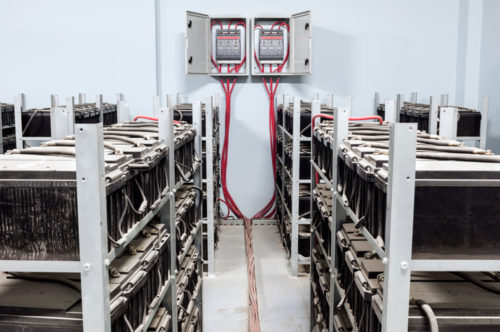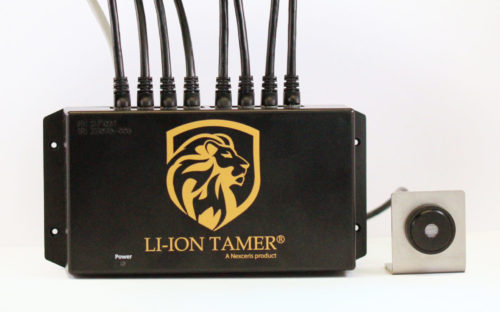By Del Williams, technical writer, Power PR
 Utility, industrial, commercial and government facilities are increasingly turning to battery energy storage systems in a variety of sizes and power outputs for reliable backup power, to avoid peak demand charges and to store energy generated by renewable power systems for use at a later time. The market is expected to exceed more than $9 billion by 2024 at a compound annual growth rate of 34%, according to a Market Research Engine report.
Utility, industrial, commercial and government facilities are increasingly turning to battery energy storage systems in a variety of sizes and power outputs for reliable backup power, to avoid peak demand charges and to store energy generated by renewable power systems for use at a later time. The market is expected to exceed more than $9 billion by 2024 at a compound annual growth rate of 34%, according to a Market Research Engine report.
Given the expected growth in this sector, coupled with the fact that most energy storage systems are designed by interconnecting a series of lithium-ion batteries, the industry is continuing to focus attention on measures designed to all-but-eliminate any potential for dangerous thermal runaway conditions.
Thermal runaway occurs when excess heat caused by defects, mechanical failures from damage or improper operation of the system creates a reaction that further increases the temperature. If left unchecked by built-in system protections or the battery management system (BMS), this process can continue to drive up temperature and pressure until the battery cell ruptures, which can cause fires in affected and adjacent cells.
Fortunately, early detection systems have been developed that can now detect a unique pre-cursor event to thermal runaway – an off-gassing in the battery cell that occurs up to 30 minutes prior to a cascading failure. This distinctive and recognizable early warning sign enables the problem to be mitigated or the system shut down before thermal runaway can even begin.
Although virtually all quality BMS equipment monitor temperature and other variables to prevent thermal runaway by triggering protections before temperatures change in an unplanned way, the early detection of off-gassing provides a critical additional layer of protection for the entire system, the facility and even personnel.
“There are hundreds, if not thousands of [battery] systems already deployed where single cell failure could result in loss of the system. So, the ability to detect cell failure before it results in thermal runaway – and stop it – could literally save the system, adjacent property, and human lives,” said Nick Warner, principal engineer and founder of Warner Energy Storage Solutions, and co-founder of Energy Storage Response Group.
Early detection
 The early detection of thermal runaway relies on four sequential stages of lithium-ion battery failure, according to Steve Cummings, director of the sensors business unit at Nexceris, a developer of gas sensors and monitors. The company worked with the U.S. Navy a decade ago to develop an off-gassing detection technology for lithium battery systems that would later be commercialized in a product called Li-ion Tamer, compatible with all lithium chemistries.
The early detection of thermal runaway relies on four sequential stages of lithium-ion battery failure, according to Steve Cummings, director of the sensors business unit at Nexceris, a developer of gas sensors and monitors. The company worked with the U.S. Navy a decade ago to develop an off-gassing detection technology for lithium battery systems that would later be commercialized in a product called Li-ion Tamer, compatible with all lithium chemistries.
“A lithium-ion battery cell first begins to fail when it is subjected to an abuse factor like heat, overvoltage, etc.,” said Cummings. “The second step is off-gassing. The third step is smoke, and the fourth step is fire. But smoke and fire often occur almost simultaneously. So, by the time smoke is detected, thermal runaway has typically already begun.”
Off-gassing usually occurs due to a breakdown of a lithium-ion battery cell electrolyte, as a result of pressure buildup. Later, temperature increases, smoke is emitted and then fire breaks out.
To enable off-gassing detection at the earliest stage of a battery event after the initial abuse, the Li-ion Tamer system offers a battery off-gas monitor and sensor network designed specifically for lithium-ion batteries.
Because the system can detect off-gassing at the ppm-level concentration range, it can detect individual cell failures without contacting the cells. This enables action to prevent thermal runaway and its spread to adjacent cells as soon as a single battery cell begins to fail.
 “Early detection could help prevent thermal runaway before it starts, particularly those related to failure of the active primary control system,” Warner said. “When I was involved with testing the Li-ion Tamer system, the earliest detection of imminent failure was 12 minutes before it occurred. For some of the most common failure modes, I’ve found that it offers the earliest possible warning of imminent failure and I consider it a best practice technique.”
“Early detection could help prevent thermal runaway before it starts, particularly those related to failure of the active primary control system,” Warner said. “When I was involved with testing the Li-ion Tamer system, the earliest detection of imminent failure was 12 minutes before it occurred. For some of the most common failure modes, I’ve found that it offers the earliest possible warning of imminent failure and I consider it a best practice technique.”
When working with tier 1 providers, it is typical to have a well-integrated BMS with enough sensors to properly monitor various aspects of lithium-ion usage, including the state of charge of individual cells and temperature in the system. However, this may not be the case when dealing with tier 2 or 3 providers that sell batteries only and leave the BMS to the EPC contractor.
“[Lower end, offshore] battery manufacturers have generally gone from monitoring every small cell group to having one thermocouple run an entire module, monitoring dozens of cells,” Warner said. “As a result, the BMS is completely dependent on a voltage indication to detect any problems with the cells. But in many cases, voltage is not the perfect indicator of something potentially going wrong in the cell.”
Even in the case of qualified tier 1 battery suppliers, Warner recommends having an independent, redundant system like Li-ion Tamer. In the same way that seatbelts and airbags combined can reduce the risk of injury in a car crash, such an approach can help a qualified EPC integrate additional complementary safety measures into a safer, more comprehensive solution.
Warner notes that the detection system’s sensitivity to lithium-ion electrolyte off-gassing is much greater than traditional sensors for other kinds of gas monitoring.
“Most sensors that detect gases are either looking for a generic hydrocarbon gas or generic level of gas, and are only detecting at one physical location,” Warner said. “The value of a Li-ion Tamer sensor is that it is specifically looking for the gas that is emitted from lithium-ion batteries. It is incredibly sensitive and able to detect it at much lower levels than any other sensor.”
Another advantage of such an advanced lithium-specific system is that it is designed to function as a network of sensors, which enhances its effectiveness in lithium-ion off-gas detection.
“Because it also allows multiple sensors to be deployed, it is much more effective at detecting gas as it disperses through the container. So, when off-gassing occurs, it is detected immediately and an alarm is sent,” Warner said.
According to Warner, the lithium-specific system is also more cost effective than traditional fixed gas sensors.
“Typical fixed gas sensors are usually intended to have two or three installed and cost from $1,500 to $4,000 each,” Warner said. “But they only measure at a certain point. If you want to extend that, you would need to buy and install 10 to 20. Then you would need to activate each individually to control the system, which adds to the cost.”
Because of the benefits of lithium-ion energy storage systems, along with lithium-specific off-gas detection systems, a growing number of facilities are installing them together.
As an example, Northern Reliability Inc. (NRI) of Waterbury, Vermont, was selected by Electric Power Research Institute (EPRI) to design and build two transportable microgrid battery systems for the U.S. Navy.
EPRI’s $2 million contract with NRI was finalized in August 2019. The project is funded in part through the California Energy Commission’s Electric Program Investment Charge (EPIC) program, and the Department of Defense’s Environmental Security Technology Certification.
The microgrid in the project will use solar and energy storage, along with Navy site generation, to provide emergency backup for blackout recovery, disaster recovery and weather/fire storm response.
Each NRI energy storage system is lithium-based and can deliver 250 kW of power on demand. The two microgrids will go through testing at the Port Hueneme Naval Base in Ventura County, California. They will then go through testing and operational use at a Naval Surface Warfare Center-Port Hueneme division data center in Southern California.
“For our military, mobile microgrids with energy storage offer a readily available, quiet power and energy reserve for military decision makers to use during day-to-day operations,” said Jay Bellows, NRI’s President & CEO. “This solution provides customers with reliable power, keeps our troops safer, enables operational flexibility, and provides the effective integration of modern-day renewable resources with legacy assets like backup diesel generators, wherever needed.”
Based on EPRI’s recommendation, NRI integrated the Navy-approved off-gas detection system into the unit’s system supervisory controller as a redundant safety solution and on-board fire protection/suppression system.
“With lithium batteries being installed all over the world, improving safety is always something that we take seriously. Even though we use the highest quality battery modules on the market today, we will always take additional steps to make sure we have as many levels of protection as possible,” Bellows said.
Del Williams is a technical writer based in Torrance, California. He writes about health, business, technology, and educational issues, and has an M.A. in English from C.S.U. Dominguez Hills.







As in any maintenance issue, early detection is critical. But what about prevention of a thermal incident in the first place?
I represent Sterling PBES a manufacturer of high power industrial Lithium-Ion batteries. Due to the industrial use of our produces, we developed a patented liquid cooling system to prevent thermal runaway.
Similar to the engine block in an internal combustion engine, the battery uses chilled water to evenly cool the cells and keep the battery at optimal temperature – to maximize lifespan. Not only does it work to improve lifespan, it also has been proven (with independent validation) to prevent thermal runaway.
The system is capable of removing more heat than can be generated when the battery is forced to overheat or is subjected to mechanical abuse. Further, accurate voltage and temperature sensors on every individual cell means our proprietary BMS hardware and software is capable of predicting if a cell is in danger of causing problems – weeks in advance of an actual incident.
Currently the SPBES system is being deployed in heavy commercial maritime applications such as offshore supply vessels, tugboats and port cranes, but we believe this cooling technology may also provide large scale land based systems with increased longevity and safety.
““A lithium-ion battery cell first begins to fail when it is subjected to an abuse factor like heat, overvoltage, etc.,” said Cummings. “The second step is off-gassing. The third step is smoke, and the fourth step is fire. But smoke and fire often occur almost simultaneously. So, by the time smoke is detected, thermal runaway has typically already begun.””
There lies the problem with the energy storage system that “smoked” in Surprise Arizona last year. If this system had been in place, the first group of cells that failed would have off gassed into this detector and allowed physical electrical isolation from the rest of the battery pack. This energy storage unit had a fire suppression system, IF this system is like the one’s in buildings, it automatically shuts down all air circulation in which case it would have shut off the air conditioning units to the container. In the hot summer, that cargo container ambient would rise rather quickly creating a faster path to thermal run away and more cascading damage.
“Based on EPRI’s recommendation, NRI integrated the Navy-approved off-gas detection system into the unit’s system supervisory controller as a redundant safety solution and on-board fire protection/suppression system.”
Most of these large utility energy storage systems will be combined into “power blocks” of individual cells. Perhaps something like 15S by 100P to make up one battery module. Monitoring this module for temperature, current in and current out as well as outgassing could trip an isolation relay to the pack buss and remove not only the failing battery pack, but allow the energy storage system to operate at a reduced capacity, until the faulty battery module can be replaced.